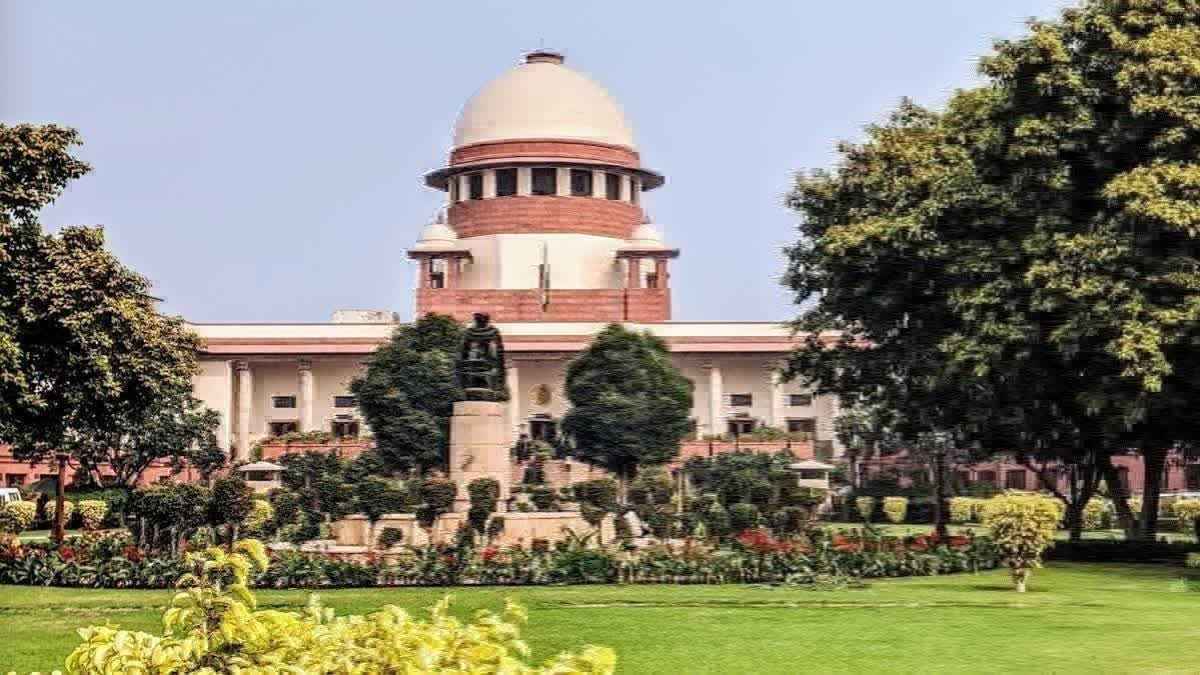New Delhi: The Supreme Court on Thursday upheld the constitutional validity of Section 6A of the Citizenship Act, 1955, inserted after the signing of the Assam accord on August 15, 1985.
A five-judge bench led by Chief Justice DY Chandrachud, and Justices Surya Kant, M M Sundresh, J B Pardiwala and Manoj Misra, by a majority view of 4:1, view upheld the constitutional validity of Section 6A in the Citizenship Act, which granted citizenship benefits to illegal immigrants -- mostly from Bangladesh, who entered Assam between January 1, 1966, and March 25, 1971. Justice Pardiwala dissented and authored a separate judgment.
Section 6A confers citizenship on those who migrated from Bangladesh to Assam until 24 March 1971. Article 6 and the proviso to Article 7 confer citizenship on a limited class. Section 6A deals with those who are not covered by the constitutional provisions, that is those who migrated (or remigrated) after 26 July 1949.
The CJI, in his 94-page opinion, said the legislative competence of Parliament to enact laws related to citizenship is traceable to Entry 17 of List I and not Article 11.
The CJI said the legislative objective of Section 6A was to balance the humanitarian needs of migrants of Indian origin and the impact of the migration on the economic and cultural needs of Indian states.
“The two yardsticks employed in Section 6A, that is migration to Assam and the cut-off date of 24 March 1971 are reasonable. Though other states share a greater border with Bangladesh, the impact of migration in Assam in terms of numbers and resources is greater. Thus, the yardstick of migration to Assam is reasonable. The cut-off date of 25 March 1971 is reasonable because the Pakistani Army launched Operation Search Light to curb the Bangladeshi nationalist movement in East Pakistan on 26 March 1971. Migrants before the operation were considered migrants of the Indian partition," he said.
The CJI said the claim of the petitioner that Section 6A is unconstitutional because instead of preventing migration to Assam, it incentivises migrants in other states to come to Assam to secure citizenship through Section 6A is erroneous.
"Section 6A does not violate Article 29(1) of the Constitution. Article 29(1) guarantees the right to take steps to protect the culture, language and script of a section of citizens. The petitioners have been unable to prove that the ability of the Assamese to take steps to protect their culture is violated by the provisions of Section 6A," said the CJI.
The CJI said Section 6A was included with the objective of reducing the influx of migrants to India and dealing with those who had already migrated. "The Assam Accord was a political solution to the issue of growing migration and Section 6A was a legislative solution. Section 6A is one more statutory intervention in the long list of legislation that balances the humanitarian needs of migrants of Indian Origin and the impact of such migration on the economic and cultural needs of Indian States," he said.
The CJI said the Centre could have extended the application of the Illegal Migrants (Determination by Tribunals) (IMDT)Act 1983, to any other state by a notification.
"However, no such notification was issued indicating that the immigration to Assam presented the Union with a unique problem in terms of magnitude and impact. Though other states such as West Bengal (2216.7 km), Meghalaya (443 km), Tripura (856 km) and Mizoram (318 km) share a larger border with Bangladesh as compared to Assam (263 km), the magnitude of influx to Assam and its impact on the cultural and political rights of the Assamese and Tribal populations is higher," said the CJI.
The data submitted by the petitioners indicates that the total number of immigrants in Assam is approximately forty lakhs, fifty-seven lakhs in West Bengal, thirty thousand in Meghalaya and three lakh and twenty-five thousand in Tripura.
"The impact of forty lakh migrants in Assam may conceivably be greater than the impact of fifty-seven lakh migrants in West Bengal because of Assam’s lesser population and land area compared to West Bengal. Thus, the singling out of Assam is based on rational considerations," said the CJI, adding that the cut-off date of 25 March 1971 is also rational.
The CJI said migrants from Bangladesh after the said date were considered to be migrants of war and not partition and the cut-off date of 25 March 1971 is reasonable.
The CJI said, "having held that both the cut-off date and the singling out of Assam is based on rational considerations, the next question is whether the yardsticks have a rational nexus with the object of the provision. The answer is in the affirmative”.
The CJI further said, "The migration from East Pakistan to Assam was in great numbers after the partition of undivided India and since the migration from East Pakistan after Operation Search-Light would increase, the yardstick has nexus with the objects of (a) reducing migration and (b) conferring citizenship to migrants of Indian origin."
The CJI said: “Section 6A would be under-inclusive only when all those who are similarly situated with respect to the object and on the application of the rational yardstick are not included. Similarly, the provision would be overinclusive only when those who are not similarly situated with respect to these two parameters are included. That not being the case, Section 6A is neither under-inclusive nor over-inclusive."
The CJI said the objective behind the enactment of the Citizenship (Amendment) Act 1985 was to deal with the larger problem of whether Bangladesh migrants of Indian origin could secure citizenship in India.
"The objective of the provision must be understood in the backdrop of the Indian policy on post-partition migration and the Assam movement. The principle of temporal unreasonableness cannot be applied to a situation where the classification is still relevant to the objective of the provision. The process of detection and conferring citizenship in Assam is a long-drawn out process spanning many decades. To strike it down due to lapse of time is to ignore the context and object of the provision”, said the CJI.
The CJI said as a matter of constitutional principle, the mere presence of different ethnic groups in a State is not sufficient to infringe the right guaranteed by Article 29(1). “Article 29(1) confers the right to ‘conserve’ which means the right to take positive steps to protect culture and language”, he said.
The CJI said he is unable with respect to agree with the observation of Justice Pardiwala that the purpose of Section 6A(3) is merely the speedy and effective identification of foreigners of the 1966-71 stream.
The petitioners submitted that Section 6A(2) is unconstitutional because the provision does not prescribe a procedure for conferring citizenship to those who migrated before 1 January 1966, unlike Section 6A(3) which prescribes a procedure for conferring citizenship to those who migrated between 1966-1971.
The CJI said Section 6A is a substantive provision conferring citizenship on persons who migrated from Bangladesh to Assam. He said that the provision provides that persons who migrated from Bangladesh to Assam before 1 January 1966 shall be deemed to be citizens of India from 1 January 1966.
Section 6 A says those who came to Assam on or after January 1, 1966 but before March 25, 1971 from specified territories, including Bangladesh, in accordance with the Citizenship Act amended in 1985, and since then are residents of the northeastern state, must register themselves under section 18 for acquiring Indian citizenship. As a result, the provision fixes March 25, 1971 as the cut-off date for granting citizenship to Bangladeshi migrants in Assam.
Section 6A was inserted into the 1955 Act in furtherance of a Memorandum of Settlement called the ‘Assam Accord’ signed on August 15, 1985, by the then Rajiv Gandhi Government with the leaders of the Assam Movement to preserve and protect the Assamese culture, heritage, linguistic and social identity.



